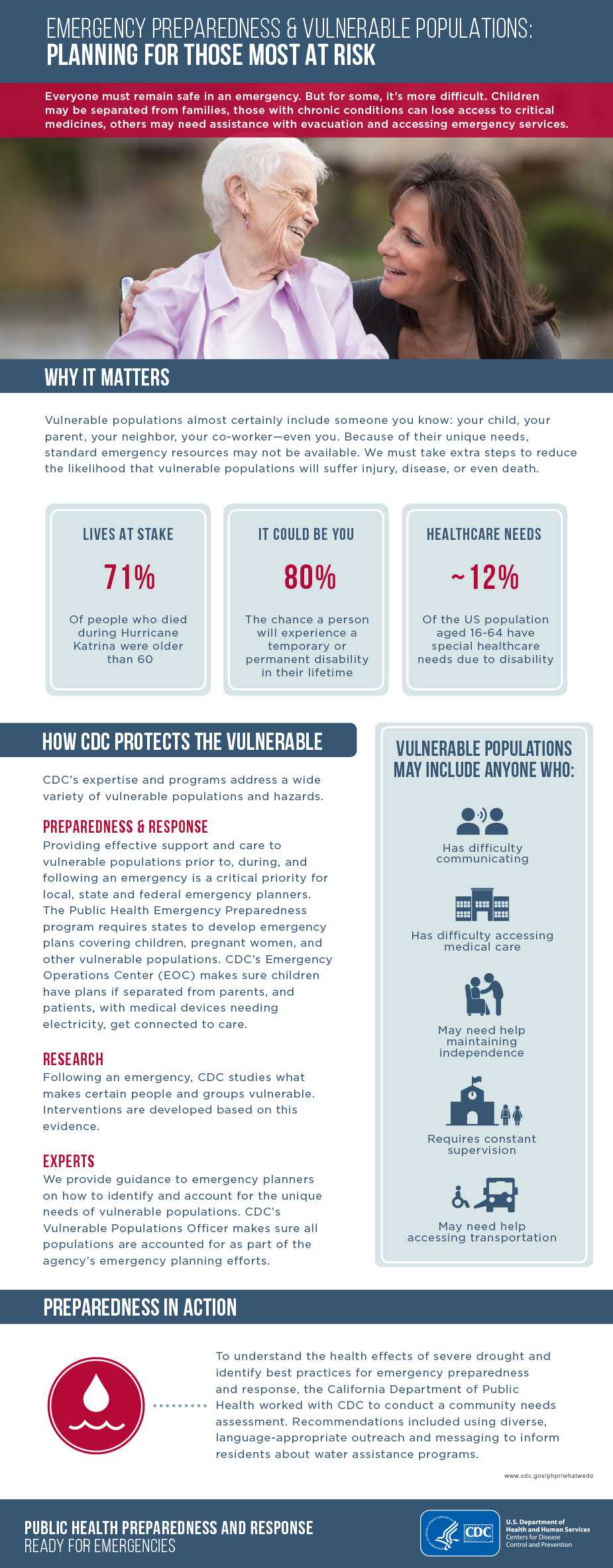Emergency Preparedness & Vulnerable Populations: Planning for Those Most at Risk.
Text Equivalent
Emergency Preparedness & Vulnerable Populations: Planning for Those Most at Risk
Everyone must remain safe in an emergency. But for some, it’s more difficult. Children may be separated from families, those with chronic conditions can lose access to critical medicines, others may need assistance with evacuation and accessing emergency services.
Why It Matters
Vulnerable populations almost certainly include someone you know: your child, your parent, your neighbor, your co-worker—even you. Because of their unique needs,standard emergency resources may not be available. We must take extra steps to reduce the likelihood that vulnerable populations will suffer injury, disease, or even death.
- Lives at Stake: 71% Of people who died during Hurricane Katrina were older than 60 Identify threats early and close to the source
- It Could be You: 80% The chance a person will experience a temporary or permanent disability in their lifetime
- Healthcare Needs: ~12% Of the US population aged 16-64 have special healthcare needs due to disability Share information rapidly and securely
How CDC Protects the Vulnerable
CDC’s expertise and programs address a widevariety of vulnerable populations and hazards.
Preparedness and Response
Providing effective support and care to vulnerable populations prior to, during, and following an emergency is a critical priority for local, state and federal emergency planners. The Public Health Emergency Preparedness program requires states to develop emergency plans covering children, pregnant women, and other vulnerable populations. CDC’s Emergency Operations Center (EOC) makes sure children have plans if separated from parents, and patients, with medical devices needing electricity, get connected to care.
Research
Following an emergency, CDC studies what makes certain people and groups vulnerable. Interventions are developed based on this evidence.
Experts
We provide guidance to emergency planners on how to identify and account for the unique needs of vulnerable populations. CDC’s Vulnerable Populations Officer makes sure all populations are accounted for as part of the agency’s emergency planning efforts.
Vulnerable Populations May Include Anyone Who:
- Has difficulty communicating
- Has difficulty accessing medical care
- May need help maintaining independence
- Requires constant supervision
- May need helpaccessing transportation
Preparedness in Action
To understand the health effects of severe drought and identify best practices for emergency preparedness and response, the California Department of Public Health worked with CDC to conduct a community needs assessment. Recommendations included using diverse, language-appropriate outreach and messaging to inform
- Page last reviewed: June 6, 2017
- Page last updated: June 6, 2017
- Content source:


 ShareCompartir
ShareCompartir
